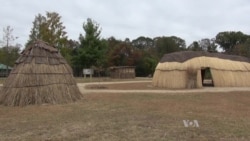There is precious little opportunity to experience what life was ike in the United States before its colonization by European settlers. Now, an American Indian village built on a park just outside Washington is taking visitors back in time to experience the way of life of America's indigenous people.
The village was built on a 16,000-square-meter lot at Patuxent River Park in Upper Marlboro, Maryland. Its features include dwellings — a 12-meter longhouse that would have served as multifamily living quarters, plus a single-family wigwam — and stations that demonstrate hide tanning, net weaving, canoe making and cooking.
Elizabeeth Hewlett, chairwoman of the Prince George's County Planning Board, said there are more than 4,000 Native Americans residing in the county, "and this was their land, right on the Patuxent. So it makes sense for us to build this village here.”
Park naturalist Tonya Johnson of the Maryland-National Capital Parks and Planning Commission, who initiated the village project, said that "we didn’t have a lot of outdoor sites where we can go and learn about the native people or the first people that were here. So I thought we should be able to get people outside in a natural environment and learn about native culture that was here.”
Authentic feel
Johnson said the village was built to be as close to authentic as possible, using natural resources — rope, grass and trees, with no nails. It took 300 teenage volunteers a year to create the village.
"It is not just something you come and see," she said. "It is still an exhibit, but it is an active exhibit you can take part in."
Visitor Kevin Youngblood said he thought the village was a valuable exhibit "because children get to see with their own eyes, with their own hands, how the Indians built their houses, how they made canoes, how they prepared dinners. I certainly didn’t know how they make canoes. They burn out the middle of the bark to help shape the canoe the way they want. That was pretty interesting.”
Hope “Spark of a Flame” Butler, one of the leaders of the Piscataway Indian tribe, said the village was special, especially to her tribe.
"Words can’t express, because this is part of where our people were over thousands of years ago," she said. "In fact, we are still here as a people. We are part of the human fabric of our mother earth. This is just reminder of the beginning, and to learn from your past, it is the only way you can help move into the future.”
Butler hopes the village also helps young American Indians get in touch with their ancestry and take an active part in keeping their heritage alive.







